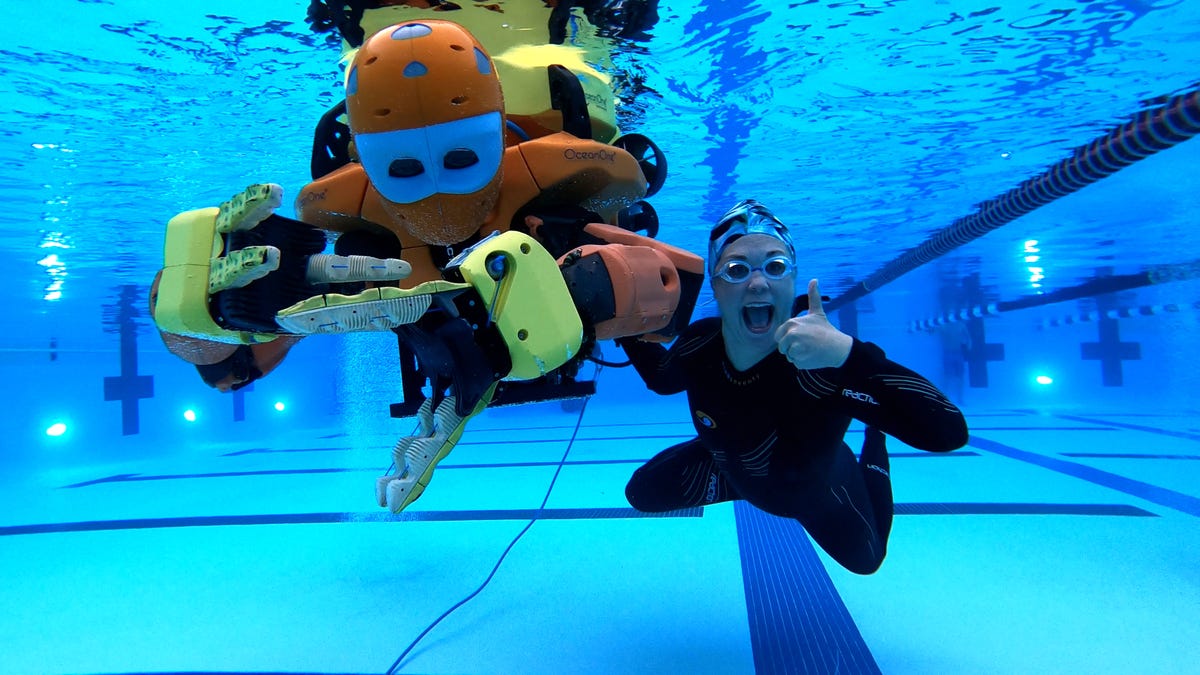
It’s a sunny afternoon at the Stanford University rec center, and I’m about to go swimming with a robot. I’ve rented my wetsuit from a friendly guy at Sports Basement (“You can take it surfing, but I’m not sure about robot diving,” he tells me) and I’m armed with a GoPro to capture my candid close-ups with the ‘bot in question.
I’m here to see the OceanOneK, a deep-water robot developed by the team at the Stanford Robotics Lab, headed up by roboticist Oussama Khatib. Capable of descending to depths of 1,000 meters (hence the “OneK” name) or a bit over half a mile, this humanoid robot is designed to offer humanlike controls in a robot body — it has a moving head with two stereoscopic cameras and two arms that can reach out and manipulate objects with its fingers.

My swim with the OceanOneK.
Kevin Heinz/CNET
Propellors across the robot’s body help it move through the water, but the real genius of the ‘bot is in the haptic controls. A human operator outside the water uses free-moving joysticks to direct the robot and move its arms, while the stereoscopic cameras provide a three-dimensional view of the underwater landscape (the operator can watch the two camera inputs in a split-screen view or with full depth by wearing 3D glasses).
The idea is that the robot can go to depths that humans can’t, all while offering the kind of agility and manual dexterity you’d get from a human diver.
“Ocean one is essentially your hands, your eyes,” says Khatib. “It’s your avatar in the water.”
The robot started life as a prototype known as the OceanOne. After initial development and testing, Khatib and his team took the OceanOne on a series of dives in the Mediterranean in 2016. But though the design worked, the team members realized they wanted to go deeper underwater. So Khatib began work on the OceanOneK — a new, stronger robot that could go almost 10 times deeper than the original robot and explore further.
But going deeper also meant redesigning the robot to survive atmospheric pressures roughly 100 times what the first robot had to withstand. To do that, Khatib and his team filled the robot’s arms with oil and installed special spring mechanisms that could compress the oil to match the surrounding water pressure. The design not only protected the sensitive electronics inside the arms from being crushed, but it also allowed the robot to float.

The OceanOneK swims past a wrecked aircraft, 67 meters underwater, off the coast of Cannes.
Frederic Osada/DRASSM/Stanford
But why build a humanoid robot in the first place? There are already commercial robots and deep-sea exploration vehicles capable of surviving deep underwater, without looking like a bright orange robot Aquaman.
According to Khatib, form follows function, namely, the ability to explore complex deep-water environments like shipwrecks and handle delicate objects like artifacts or corals.
“In this environment, you cannot work with one arm or one hand. If you put your arm behind your back and think about how you’re going to do things, It’s really difficult. … So you need two arms,” he said. “Then you need to see your hand as you move. Already you get the upper body of a human. But remember, this is a mermaid, it’s not a human. We didn’t put legs on it.”

Professor Oussama Khatib shows me the haptic controls of the OceanOneK. Two free-floating hand controls allow you to move the hands and direct the robot underwater (the laptop screen shows the vision coming in from the robot’s “eye” cameras).
Kevin Heinz/CNET
In 2022, Khatib and his team of engineering students took the OceanOneK back to the Mediterranean, testing the robot at different depths. For Khatib, the highlight was diving down to the wreck of an Italian steamship, Le Francesco Crispi, 500 meters underwater.
“Approaching the Crispi was one of the most incredible experiences I’ve ever had,” said Khatib. “You are looking through the eyes of the robot, and you see the hands of the robot, and now they are your hands, you are moving them.”
Back at Stanford University, I got behind the controls by the side of the pool and controlled the OceanOneK. It was surreal to see the robot’s hands stretching out in front of me, its fingers opening and shutting as I opened and shut my hands on the controls.
But the most impressive part was zipping into my wetsuit and diving in. Getting up close to the robot underwater it was amazing to see how human it looked — like I was swimming alongside a fellow diver (albeit one who could hold its breath longer).
While a university rec center pool is a long way from a submerged shipwreck, it was easy to see how the OceanOneK could revolutionize deep-sea exploration. While we might not be able to free dive 500 meters underwater to see a historic shipwreck in person, the OceanOneK could get us up close and personal, giving us an experience that’s close to the real thing.

